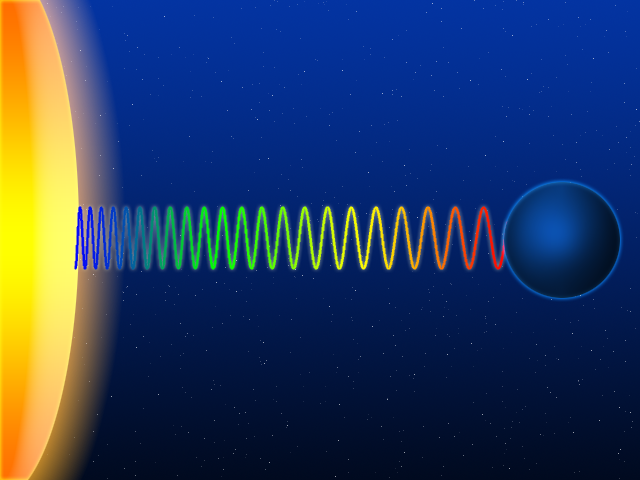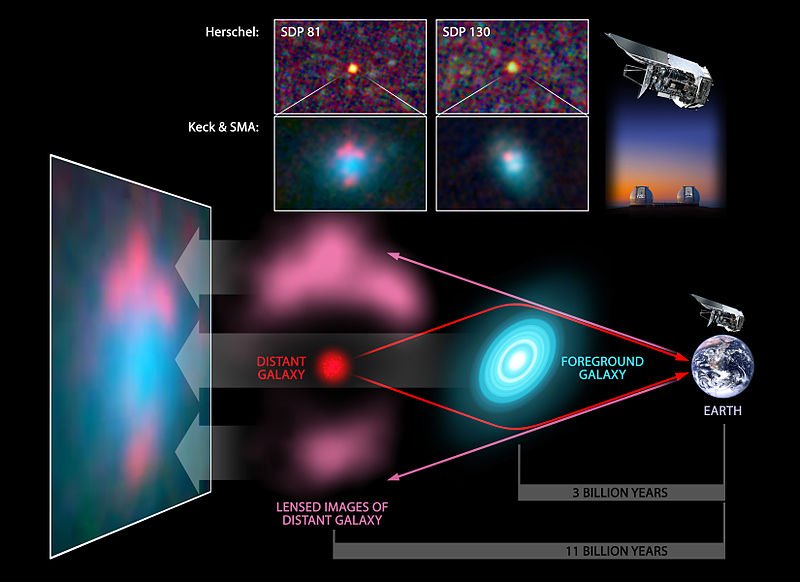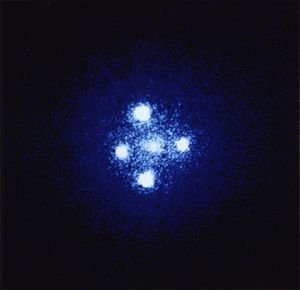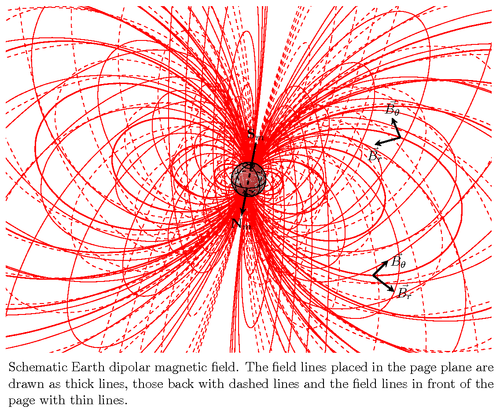The Big Bang model says that all distant galaxies are moving away from us. This, it is said, is due to expansion of space. Additionally, dark energy is said to cause this expansion to accelerate.
What it does not mention is that this is based on an assumption. Specifically, the assumption that motion is the cause of the observation behind these concepts to begin with.
When we observe distant galaxies, we do not see motion away; rather, we analyze the light spectrum of these galaxies to determine what their composition is. When we do this, we see absorption lines that tell us what the galaxy is made of.
These absorption lines are at very specific frequencies locally on Earth. However, distant galaxies all have their absorption line patterns shifted towards the red spectrum in what is known as a redshift:
This is what we actually see. Redshift can occur by motion away from an observer in what is known as Doppler shift. However, it can also be caused by gravity in what is known as gravitational redshift.
Thus, the big assumption is that motion is the cause and gravity is not.
As a result of associating this redshift with Doppler shift, it was assumed that motion was the cause. This led to the conclusion that all distant galaxies are moving away from us, therefore they were once all together, therefore there was a Big Bang. However, this assumption ran into immediate problems as redshifts greater than the value of 1 were observed. If Doppler shift, in and of itself, were the cause, then this would mean that those galaxies were traveling faster than the speed of light.
To "correct" for this apparent breaking of the laws of physics, a correlation of redshift per distance known as "Hubble's Law" was extracted from the redshift observations. This, then, was labeled "cosmological redshift."
"Cosmological redshift", the term assigned to the blue line of this graph, was then said to be caused by something else, and so the galaxies were not physically traveling faster than the speed of light. This "something else" was then decided to be something new and never heard of before: expansion of space. Since then, all redshift observations are translated into velocity (km/s) as shown on this graph due to these assumptions, even though the observation itself is redshift and redshift alone.
So then, it was said, even though the galaxies are not physically traveling faster than the speed of light, they were still said to be moving away from us faster than the speed of light. However, it was no longer breaking the laws of physics, it was said, because space is expanding in order to cause this motion away.
As we looked even further in space through improvements in technology, we recognized that the rate of redshift per distance was not linear as "Hubble's Law" implied. Rather, it was exponential at sufficiently large distances. Hubble's Law, and thereby "expansion of space", were no longer adequate explanations for the redshift observations. And so on top of "expansion of space", another new phenomenon was introduced that was said to cause this rate of redshift to accelerate: dark energy.
Both expansion of space and dark energy are the results of the assumption that Doppler shift, thereby motion, was the cause of the observations. Gravitational redshift, the alternative possible explanation, was not considered a possible explanation and so motion remained the chosen cause.
This is an extremely big assumption. If gravitational redshift could be shown as the cause, it would thereby disprove the existence of both "expansion of space" and "dark energy", as they would be shown to be the results of misinterpretations due to an invalid assumption. However, it was never reconsidered.
Importantly, this observation of redshift per distance is in all directions in space and so it was concluded that motion must be the cause. However, this assumption led to the introduction of new concepts to the Standard Model. Using logic, Occam's Razor strongly suggests that there is a flaw in the assumption due to this adding to the fundamentals of physics. The goal of physics is to reduce the model, not to make it more complex by adding to it.
When light moves away from a source of gravity, the force of gravity pulls on the light and stretches it into a redshift (or blueshifts the light when it travels towards the source of gravity):

Source
There was no immediate explanation for how gravitational redshift could produce the observations, and so it was assumed that it did not and thereby, through deduction, motion did. Again, this assumption led to a more complex model.
However, gravitational redshift can and, due to not needing additional explanations, does produce the observations of redshift per distance of galaxies in all directions.
How it does this is literally not straight-forward and thus, without careful consideration, the mechanism behind it was not recognized.
Using pattern recognition, we see that the Moon orbits the Earth, which orbits the Sun, which orbits the Supermassive Black Hole at the center of our Milky Way galaxy. This pattern implies that logically the Milky Way galaxy should orbit another larger mass.
As this larger mass would be in one position relative to Earth, on the surface it would appear that it is only capable of producing redshift in the light of those galaxies in its direction. The light, traveling to Earth, would move away from this object and thereby be redshifted. However, the galaxies on the opposite side of Earth to this object would have their light travel towards it to arrive at Earth and be blueshifted, creating a dichotomy of half blueshifted galaxies and half redshifted galaxies.
Notably, within a relatively short distance, we do see this dichotomy.
Cosmography of the Local Universe, Courtois et al. @11:00
However, beyond a certain distance, all galaxies are redshifted. And so, on the surface, it appears that gravitational redshift cannot be the cause. The missing link, however, is gravitational lensing. When light is influenced by gravity, its direction of travel can be bent so that it curves around the object.
Presently, we have only been aware of this effect being caused by observations such as when the light passes near a galaxy and produces an Einstein Cross or an Einstein Ring:
However, this happens on a much larger scale than meets the eye. As can be seen from the local dichotomy described by Courtois et al., light that travels short distances to reach Earth is redshifted from the galaxies in the direction of the Great Attractor and blueshifted from the galaxies in the direction opposite of the Great Attractor.
Due to the short distance of travel, the light from these galaxies is not greatly influenced by the gravitational lensing of the Great Attractor and so they show the dichotomy expected from a "straight-forward" interpretation of gravitational redshift. As distance increases, however, the light is influenced over larger and larger lengths of time by the Great Attractor's gravity, and so it is able to be drastically gravitationally lensed.
The more distant the galaxy, in fact, the more it has been gravitationally lensed because the Great Attractor is so massive that it gravitationally lenses all light in our observable universe so that it bends back directly towards it. And like neutrinos passing through the Earth, this light then physically passes through the Great Attractor. As it does so, the force of gravity then is in the opposite direction and this causes it to then gravitationally lens back towards the Great Attractor into a Figure-8 flow pattern.
Light from distant galaxies, then, does not travel in a straight line to Earth but rather in a Figure-8 pattern, repetitively passing through the Great Attractor in this Figure-8 pattern, and after one pass or many, it then arrives at Earth, and can do so from any angle.
Actual vs. assumed direction of light travel from distant galaxy, from The Simple Reality.
From this Figure-8 orbital flow pattern, gravitational redshift per distance is produced. Notably and non-trivially, this is how gravity causes electromagnetism, by the flow of particles in Figure-8 orbital patterns, the summation of which produces the observation of an electromagnetic field, which so drastically reduces the fundamental principles of physics that it shows that this is necessarily what is happening.
Due to the Figure-8 orbital, gravitational redshift is produced because with each pass through a loop of the Figure-8 pattern, the light specifically moves radially a certain distance out and the same distance back, the radial motions canceling with one another as redshift and blueshift are equal, and it moves from one side of the loop to the other. It is due to this orbital motion that redshift is produced, and so with each pass through a loop of the Figure-8 pattern, additive gravitational redshift per distance is produced. This leads to the observation known as Hubble's Law and called "cosmological redshift."

Vectors of radial and orbital motion in Figure-8 pattern, from The Simple Reality.
As the redshift increases, it causes the physical size of the Figure-8 orbital to get smaller as the particles of light become less massive (light is waves of infinitesimal particles) and they are more easily pulled out of their trajectory by the force of gravity. Due to the inverse radius-squared function of gravity, the smaller the size of the Figure-8 pattern, the larger the force of gravity exponentially.

Shrinking Figure-8 orbital due to increasing redshift, from The Simple Reality.
This, in turn, leads to the observed accelerating rate of redshift per distance.
Therefore, gravitational redshift causes the observations that are most critical to the Big Bang model, demonstrating how the Big Bang is indeed based on a Big Assumption.
For more information, visit CascadingUniverse.org.





